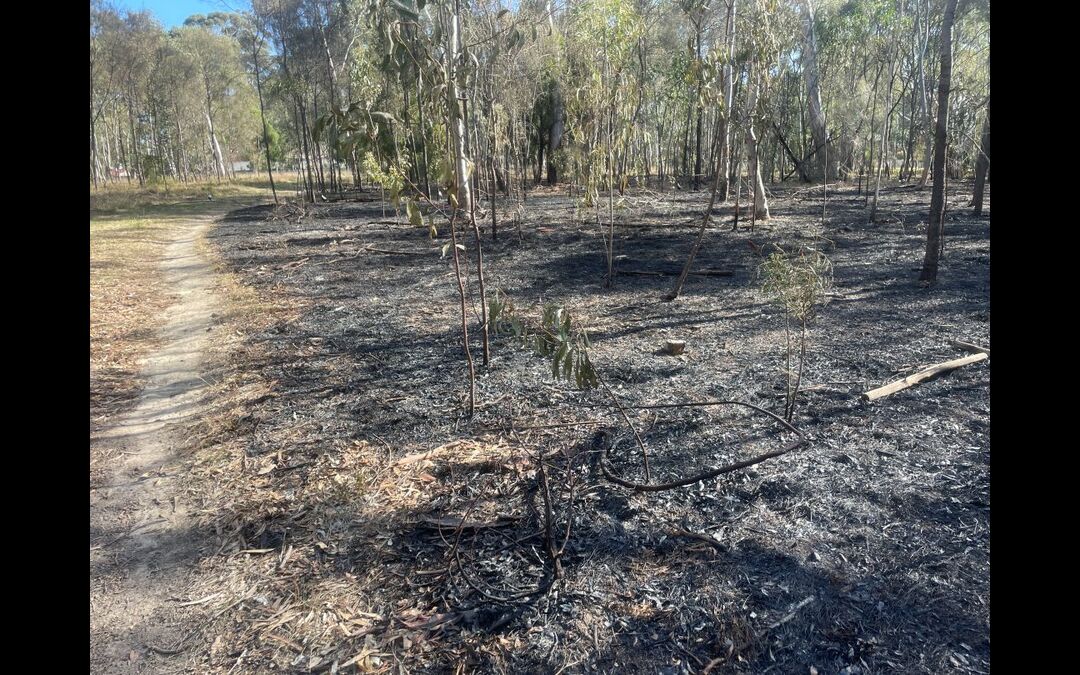Bringing back balance with ecological burning

In Victoria’s dry forests and native grasslands, fire often gets a bad rap. But when used thoughtfully and respectfully, fire can be a powerful force for regeneration.
Some people may have noticed smoke from Cherry Street Reserve in Macleod a few weeks ago. It wasn’t a fire, but a very small cool ecological burn. The reserve, along with Gresswell Forest in Bundoora/Watsonia, is one of the best patches of bush in our area. Ecological burning, when planned and done well in the right types of forest and grasslands, is excellent for biodiversity.
For tens of thousands of years, Aboriginal people used fire to care for Country – applying it at the right time, in the right way, to support healthy landscapes. Today, those same principles are being revived through ecological burning.
What is ecological burning?
Unlike destructive bushfires, ecological burns are small, cool, and patchy. They’re carefully planned to support biodiversity, reduce fuel loads and mimic the natural fire cycles many Australian ecosystems depend on.
When used properly, ecological burning can help native plants regenerate, give animals better habitat, and even bring rare species back from the brink.
Fire brings life to the bush
Many of our native species have evolved with fire: some need it to survive.
Take the Silver Banksia (Banksia marginata) that was once widespread in the Plenty and Yarra Valleys. This iconic tree holds onto its seeds in woody cones, which only open in response to fire. After a burn, the cones release their seeds onto the ash-covered ground, where there’s less competition and more light – a perfect start for new life.
Other species like Kangaroo Grass (Themeda triandra) and Bulbine Lily (Bulbine bulbosa) also bounce back strongly after a burn, thriving in the cleared, nutrient-rich conditions.
And it’s not just the plants that benefit.
Helping threatened animals like the brush-tailed phascogale
Well-planned burns support fauna also, including the Brush-tailed Phascogale (Phascogale tapoatafa), a small, threatened marsupial that still survives in patches of dry forest around Melbourne’s north-east.
These agile climbers need tree hollows to nest in and open ground to forage for insects. When understorey vegetation becomes too thick, phascogales struggle to find food. Ecological burns help maintain a mosaic of habitats –open areas for foraging, alongside mature trees that provide shelter.
By reducing fuel loads, burning also lowers the risk of hot, uncontrolled bushfires that (amongst other things) destroy the tree hollows these animals depend on.
Weed control and wildflower recovery
Ecological burning can also knock back invasive weeds that smother native vegetation. Many introduced grasses and woody weeds don’t cope well with fire, while native plants have evolved to bounce back stronger. The recent burn at Cherry Street Reserve was obviously low intensity and appears not to have killed any plants. Once the Autumn rains arrive, the plants (and therefore the insects, fungi and animals) will thrive.
In the grassy woodlands like around Harry Pottage Reserve and Banyule Northern Grassland Reserve in Heidelberg West, burns can trigger the return of wildflowers like the purple flowering Chocolate Lily (Arthropodium strictum), and even native orchids, after years of dormancy under dense leaf litter.
Guided by traditional knowledge
One of the most important parts of ecological burning is the leadership of Traditional Owners. Their fire practices are shaped by deep, generational knowledge of local landscapes, plants and animals.
Many burns today are planned and carried out in collaboration with Traditional Owner groups and are often referred to as cultural burning. Examples of this include a recent ecological burn at Bolin Bolin Billabong on the Yarra in Bulleen led by Forest Fire Management Victoria together with the Wurundjeri Land Council Narrap Team rangers.
Looking forward
Ecological burning isn’t a one-size-fits-all solution. It needs to be done with care, local knowledge, and ongoing monitoring. But when done right, it’s one of the most effective tools we have for restoring balance to the land.
By blending science with ancient fire practices, we’re learning how to work with fire – not just fight it – and bring health and resilience back to our bushland.
Further reading:
- Cheal, D. (2010) Growth stages and tolerable fire intervals for Victoria’s native vegetation data sets. Fire and Adaptive Management Report No. 84. Department of Sustainability and Environment, East Melbourne, Victoria, Australia.
- Forest Fire Management Victoria – Cultural fire
- NITV ‘Aboriginal cultural burning returns to regional Victoria’ – short video featuring Uncle Dave Wandin who recently spoke at the Sustainable Macleod Community Garden about cool burning amongst other things.
Written by Jen Willis
